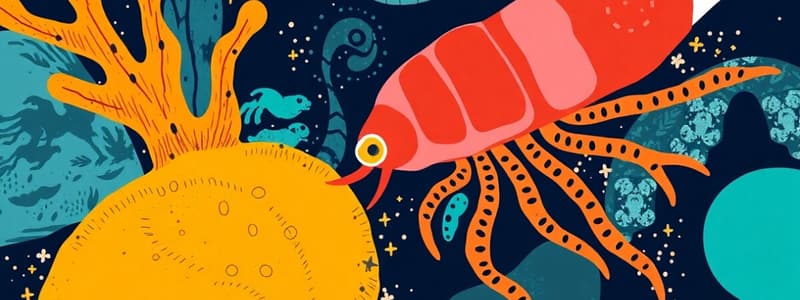Podcast
Questions and Answers
Which group of animals constitutes 95 percent of known organisms in the animal kingdom?
Which group of animals constitutes 95 percent of known organisms in the animal kingdom?
- Invertebrates (correct)
- Mammals
- Birds
- Vertebrates
Porifera, or sponges, have a brain and a complex organ structure.
Porifera, or sponges, have a brain and a complex organ structure.
False (B)
What is the primary function of the pores on a sponge's body?
What is the primary function of the pores on a sponge's body?
To absorb water and oxygen and discard waste.
Coelenterates, like jellyfish, are primarily found in ______ environments.
Coelenterates, like jellyfish, are primarily found in ______ environments.
Which of the following does NOT belong to the group of coelenterates?
Which of the following does NOT belong to the group of coelenterates?
Worms breathe through their mouths.
Worms breathe through their mouths.
What role do worms play in agriculture?
What role do worms play in agriculture?
Match the following invertebrates with their characteristics:
Match the following invertebrates with their characteristics:
What characteristic is common to all arthropods?
What characteristic is common to all arthropods?
Mollusks can only reproduce asexually.
Mollusks can only reproduce asexually.
Name one example of a mollusk that has a hard external shell.
Name one example of a mollusk that has a hard external shell.
Echinoderms have a _______ and spiny surface.
Echinoderms have a _______ and spiny surface.
Match the following groups with their characteristics:
Match the following groups with their characteristics:
Which of the following statements about echinoderms is true?
Which of the following statements about echinoderms is true?
Arthropods have more than two antennae.
Arthropods have more than two antennae.
What is the body division found in arthropods?
What is the body division found in arthropods?
Flashcards
Invertebrates
Invertebrates
Animals without backbones.
Porifera (Sponges)
Porifera (Sponges)
Simple aquatic invertebrates with porous bodies; they filter feed.
Coelenterates
Coelenterates
Aquatic invertebrates with a central body opening and tentacles.
Worms
Worms
Signup and view all the flashcards
Aquatic Invertebrates
Aquatic Invertebrates
Signup and view all the flashcards
Invertebrate Groups
Invertebrate Groups
Signup and view all the flashcards
Filter Feeding
Filter Feeding
Signup and view all the flashcards
Invertebrate Abundance
Invertebrate Abundance
Signup and view all the flashcards
Mollusks
Mollusks
Signup and view all the flashcards
Mollusks Reproduction
Mollusks Reproduction
Signup and view all the flashcards
Arthropods
Arthropods
Signup and view all the flashcards
Arthropod Groups
Arthropod Groups
Signup and view all the flashcards
Echinoderms
Echinoderms
Signup and view all the flashcards
Echinoderm Habitat
Echinoderm Habitat
Signup and view all the flashcards
Arthropod Exoskeleton
Arthropod Exoskeleton
Signup and view all the flashcards
Arthropod Movement
Arthropod Movement
Signup and view all the flashcards
Study Notes
Invertebrates
- Invertebrates make up 95% of known organisms in the animal kingdom
- They are multicellular animals that lack a backbone
- They are divided into six groups
Porifera (Sponges)
- Unusual organisms, resembling plants, but are invertebrates
- Simple body structure, lacking tissues, organs, brain, blood, and muscles
- Vary in color, size, and shape
- Live in aquatic environments (freshwater or saltwater)
- Young forms are mobile larvae, but adults are sessile (don't move)
- Obtain food and oxygen from water passing through pores
- Some produce toxins for protection
Coelenterates (Sea Anemones, Fan Coral)
- Aquatic invertebrates, primarily marine
- Have a central opening for feeding, surrounded by tentacles
- Use tentacles to capture prey
- Simple nervous systems
- Reproduce sexually or asexually
- Many produce toxins for defense
- Includes jellyfish, sea anemones, and corals
Worms
- Invertebrate animals with long, soft bodies
- Some have segmented bodies
- Lack limbs, moving by sliding or contracting
- Live in various environments (underground, water, humid places)
- Breathe through their skin
- Important in agriculture, consuming and decomposing organic matter for soil enrichment
- Reproduce sexually or asexually
Mollusks (Slugs, Squid)
- Can live on land and in the sea
- Soft bodies, some with hard external shells for protection
- Some have one shell (e.g., conch, snail), others have two-layered shells (e.g., clams)
- Some have no shell (e.g., slugs)
Arthropods
- 75% of animals belong to this group
- Characterized by an exoskeleton for protection
- Bodies are divided into segments
- Include Insects, Arachnids, Crustaceans, and Myriapods
Insects
- Typically have six legs
- Two antennae
- Eyes on each side of the head
- Some produce toxins (e.g., bees)
Arachnids
- Eight legs
- Lack antennae
- Bodies divided into cephalothorax and abdomen
- Many are venomous
Crustaceans
- Mostly aquatic
- Bodies include cephalothorax and abdomen
- Strong shell
- Often have two antennae
- Many have pincer-like front legs
Myriapods
- Many legs
- Two antennae
Echinoderms (Starfish, Sea Urchins)
- Star- or round-shaped
- No distinct head
- Have small feet for movement
- Internal skeleton made of calcareous plates
- Reproduce sexually
- Live in various marine environments
- Some have 5 arms like starfish
Studying That Suits You
Use AI to generate personalized quizzes and flashcards to suit your learning preferences.



